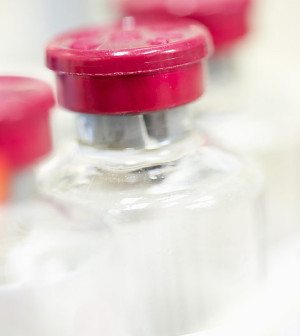- Skip Storing This Everyday Product in the Fridge Door
- Green Tea + B3 Pairing May Boost Brain Health
- Navigating Your Midlife Crisis: Embracing New Possibilities
- City Raccoons Showing Signs of Domestication
- Mapping the Exposome: Science Broadens Focus to Environmental Disease Triggers
- One Week Less on Social Media Linked to Better Mental Health
- Your Brain Changes in Stages as You Age, Study Finds
- Some Suicide Victims Show No Typical Warning Signs, Study Finds
- ByHeart Formula Faces Lawsuits After Babies Sickened With Botulism
- Switch to Vegan Diet Could Cut Your Greenhouse Gas Emissions in Half
Advisers Endorse HPV Test for Cervical Cancer Checks


An HPV test recently approved by U.S. health officials is an effective way to check for cervical cancer, two leading women’s health organizations said Thursday.
The groups said the HPV test is an effective, one-test alternative to the current recommendation of screening with either a Pap test alone or a combination of the HPV test and a Pap test.
However, not all experts are in agreement with the move: the largest ob-gyn group in the United States, the American College of Obstetricians & Gynecologists (ACOG) is still recommending that women aged 30 to 65 be screened using either the Pap test alone, or “co-tested” with a combination of both the HPV test and a Pap test.
The new, so-called interim guidance report was issued by two other groups — the Society of Gynecologic Oncology and the American Society for Colposcopy and Cervical Pathology. It followed U.S. Food and Drug Administration approval last year of the cobas HPV test as a primary test for cervical cancer screening.
The HPV test detects DNA from 14 types of HPV — a sexually transmitted virus that includes types 16 and 18, which cause 70 percent of cervical cancers.
The two medical groups said the interim guidance report will help health care providers determine how best to include primary HPV testing in the care of their female patients until a number of medical societies update their guidelines for cervical cancer screening.
“Our review of the data indicates that primary HPV testing misses less pre-cancer and cancer than cytology [a Pap test] alone. The guidance panel felt that primary HPV screening can be considered as an option for women being screened for cervical cancer,” interim guidance report lead author Dr. Warner Huh said in a news release from the Society of Gynecologic Oncology. Huh is director of the University of Alabama’s Division of Gynecologic Oncology
The FDA approved the cobas HPV test last April as a first step in cervical cancer screening for women aged 25 and older. Roche Molecular Systems Inc., headquartered in Pleasanton, Calif., makes the test.
Thursday’s interim report recommends that primary HPV testing should be considered starting at age 25. For women younger than 25, current guidelines recommending a Pap test alone beginning at age 21 should be followed.
The new recommendations also state that women with a negative result for a primary HPV test should not be tested again for three years, which is the same interval recommended for a normal Pap test result. An HPV test that is positive for HPV 16 and 18 should be followed with colposcopy, a procedure in which the cervix is examined under illumination and magnification.
“The introduction of cervical cytology screening [the Pap test] was truly one of the great breakthroughs in medicine, and has saved countless lives,” Dr. Herschel Lawson, chief medical officer at the American Society for Colposcopy and Cervical Pathology, said in the news release.
“We are lucky that we have so many tools available now to improve cervical cancer prevention efforts and afford patients options depending on their individual situations. We’ll continue to work to find the best way to combine screening tools with other prevention efforts like HPV vaccines, for the early detection and treatment of cervical cancer,” he said.
“The most important message for providers and the community is that women should be screened for cervical cancer. Screening saves lives,” Lawson added.
However, experts at ACOG said Thursday that it’s too early to move to an HPV test-only screening model. They are standing by their recommendation for a combination of the HPV test and the Pap smear.
The reason? HPV infection is common among younger women, and often resolves on its own, so a positive test result might lead to too many invasive follow-up tests. While it’s possible that the HPV test “can” replace the Pap smear altogether, there’s not enough evidence at this time to say that it “should,” ACOG said.
HPV is thought to cause the majority of cervical cancers. Certain strains, such as HPV 16 and 18, are most strongly tied to these tumors. The virus also causes genital warts in both men and women and certain head and neck cancers.
The American Cancer Society estimates that there will be about 12,900 new cases of invasive cervical cancer diagnosed in 2015, and about 4,100 women will die from the disease.
According to the cancer society, cervical cancer was once a leading cause of cancer death for American women. But in the last three decades the death rate has dropped more than 50 percent. The Pap test is the big reason cited for the decline.
The interim guidance report was published online Jan. 8 in the journals Gynecologic Oncology, the Journal of Lower Genital Tract Disease and Obstetrics and Gynecology.
More information
The U.S. National Cancer Institute has more about cervical cancer screening.
Source: HealthDay
Copyright © 2025 HealthDay. All rights reserved.










